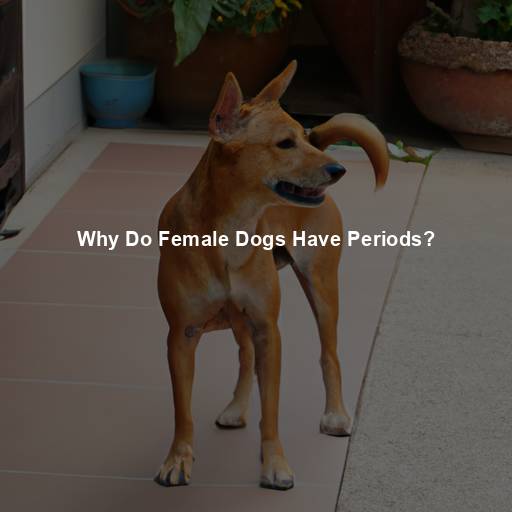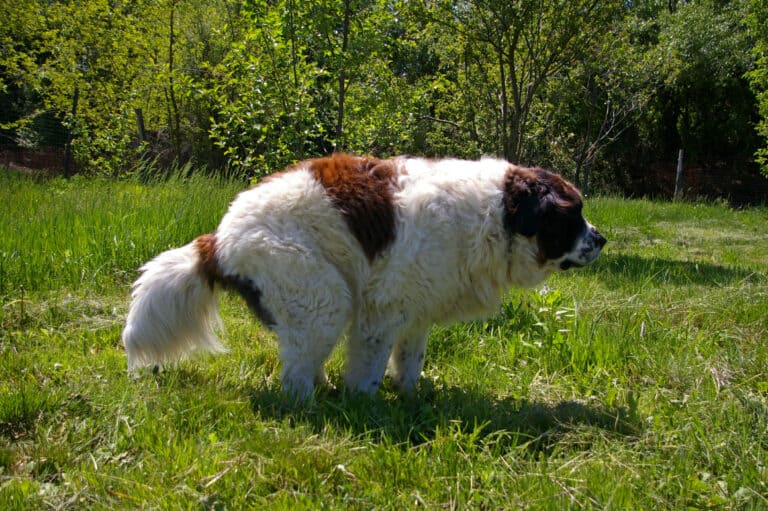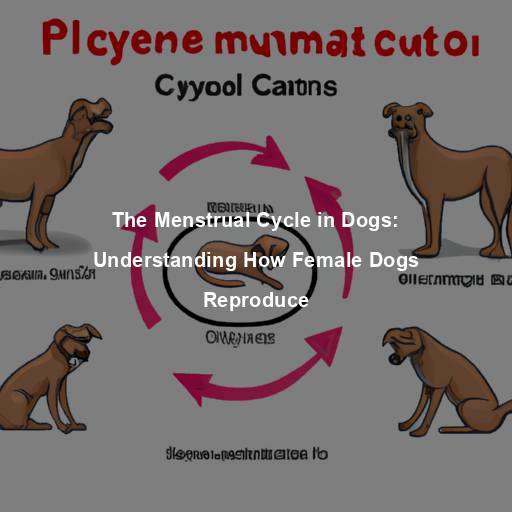Why Do Female Dogs Have Periods?
Last Updated on October 21, 2023 by Evan
Contents [hide]
- 1 Understanding the Reproductive Cycle of Female Dogs
- 2 FAQs – Why do female dogs have periods?
- 2.1 What is a period in female dogs?
- 2.2 What is the purpose of a period in female dogs?
- 2.3 How often do female dogs have periods?
- 2.4 How long do periods or estrus cycles last in female dogs?
- 2.5 Are there any visible signs of a period in female dogs?
- 2.6 Can female dogs get pregnant during their period?
- 2.7 How can I help my female dog during her period?
- 2.8 Are there any health concerns related to a dog’s period?
- 2.9 Can a dog’s period be stopped or prevented?
Understanding the Reproductive Cycle of Female Dogs
Like humans, female dogs go through a natural reproductive cycle called estrus or heat, during which they experience periods. These periods are essential for their reproductive process, but have you ever wondered why they occur? In this article, we will unravel the mystery behind why female dogs have periods and take a closer look at the different stages of their reproductive cycle. Get ready to be amazed by the fascinating world of canine fertility!
The Purpose of Estrus
Estrus is a vital part of a female dog’s reproductive system. It is during this period that a female dog is fertile and capable of conceiving offspring. Nature has designed this cycle to ensure the survival and continuation of the species. When a female dog goes into heat, her body undergoes hormonal changes that prepare her for potential mating and pregnancy.
The Phases of the Reproductive Cycle
As we delve into the intricate world of a female dog’s reproductive cycle, we encounter a tapestry of four enigmatic phases: proestrus, estrus, diestrus, and anestrus. These distinct stages, each with its own bewildering set of characteristics, contribute to the complex journey of a dog’s menstrual periods. Join us on this captivating exploration as we unravel the secrets behind the purpose and nature of these phases in a female dog’s reproductive journey.
Proestrus
Welcome to the fascinating world of a dog’s reproductive cycle! Proestrus, the thrilling maiden phase, sets the stage for potential wooing and lasts approximately 9 to 10 days. As the hormones dance within her, a female dog experiences intriguing changes that prime her body for the possibility of budding romance. One of the most captivating signs of proestrus is the emergence of a gentle, crimson discharge, often causing a curious parallel to be drawn with a human period.
Estrus
Ah, the enigmatic phase of estrus, commonly referred to as the “heat” phase, emerges after proestrus and unfolds its perplexing nature for approximately 5 to 9 days. It is during this mysterious period that a female dog reaches her peak fertility and her allure to potential mates grows inscrutably strong. As if shedding its previous crimson cloak, the weltering discharge undergoes a transformation, transitioning into lighter hues or even vanishing completely. Intriguingly, the behavioral landscape also undergoes a tantalizing metamorphosis, with female dogs exhibiting heightened friendliness and an overtly flirtatious demeanor towards their male counterparts.
Diestrus
After the heated frenzy of estrus, diestrus emerges like a perplexing enigma, enveloping the female dog in a perplexing haze for a period of about two to three months. While diestrus is the time for potential pregnancy to take root, it also serves as a delicate interlude where the canine body readies itself for the next reproductive cycle. During this enigmatic phase, the signs of diestrus fade into the background, slowly unraveling the reproductive system until it returns to a state of rest, leaving no trace of the passionate flares that came before.
Anestrus
Have you ever wondered what happens to a female dog’s reproductive system when it’s not in heat? Well, let me introduce you to the mysterious phase called anestrus. Serving as the ultimate resting phase, anestrus lays a perplexing veil of inactivity upon the reproductive cycle. Lasting for what can feel like an eternity, this phase sees no hormonal shifts or tantalizing signs of heat.
The Importance of Spaying
While the reproductive cycle of female dogs is a natural process, it is essential for pet owners to consider the implications and responsibilities that come with it. If you do not intend to breed your dog, spaying is a recommended option. Spaying, also known as ovariohysterectomy, involves the surgical removal of the ovaries and uterus, preventing the occurrence of future heat cycles.
Benefits of Spaying
When it comes to spaying, the perks are plentiful and extend to both furry friend and human companion alike. From ensuring a healthier and happier pup to fostering a stronger bond between owner and pet, the advantages of spaying are truly abundant. With countless benefits at hand, it’s no wonder why this procedure proves to be a top choice for responsible dog owners seeking to provide the best care for their beloved four-legged pals.
In a society where responsible pet ownership is paramount, a pressing issue that demands attention is the prevention of unwanted pregnancies and the subsequent litters of adorable yet homeless puppies. It is imperative for pet lovers to embrace the significance of taking proactive measures such as spaying and neutering their furry companions, thus avoiding the potential burden of unplanned pregnancies and the perplexing increase in the number of homeless canines. By championing responsible pet parenthood, we can foster a future where every wagging tail finds a loving forever home.
Discover the astonishing advancements in reproductive health that can potentially reduce the likelihood of developing debilitating conditions like uterine infections and mammary tumors. Unveiling groundbreaking research and innovative techniques, this captivating feature explores the perplexing world of reproductive ailments and sheds light on the latest preventive measures, bringing hope and optimism to those seeking to safeguard their well-being. Delve into the burst of knowledge that might just revolutionize the way we approach reproductive diseases and empower individuals to take control of their own health. Join us on this extraordinary journey as we unravel the complexities of these conditions and unravel the enigma surrounding their prevention.
Do you ever wonder how to make your furry friend’s life a little less ruff during those hot summer days? Say goodbye to the endless cycle of behavioral changes, from restlessness to aggression, not to mention the constant attention from male dogs. Discover a solution that will bring harmony back into your pet’s life and provide them with the calmness they deserve.
Common Misconceptions
There are a few common misconceptions surrounding female dog periods that are important to address:
- Female dogs do not experience menstruation: Unlike human females, who shed their uterine lining during menstruation, female dogs reabsorb the uterine lining if they do not conceive.
Every doggo is unique, and so is their reproductive cycle! The length and frequency of our furry companions’ periods can vary like a game of hide-and-seek. Factors like breed, age, and overall health add an extra dash of mystery to the equation. So, don’t be puzzled if your pup throws some surprises at you – just keep an eye out for any concerns and let the experts lend a helping paw! - Behavioral changes during estrus are normal: It is normal for female dogs to exhibit behavioral changes during estrus. These changes are driven by hormonal fluctuations and are part of the natural reproductive process.
Estrogen and Progesterone
When it comes to the fascinating world of canine reproduction, hormones take the center stage, orchestrating a delicate symphony within female dogs’ reproductive cycles. In this captivating ballet, two key players, estrogen and progesterone, harmonize to dictate and coordinate the various phases of this mysterious dance. These hormones hold the power to unlock the enigmatic secrets behind the mesmerizing journey of doggy motherhood.
During proestrus, the initial phase of the reproductive cycle, estrogen levels begin to rise. This increase in estrogen triggers the release of luteinizing hormone (LH), which subsequently leads to the release of eggs from the ovaries. As proestrus transitions into estrus, estrogen levels continue to rise, preparing the female dog’s body for potential mating and pregnancy.
After the female dog goes through the fascinating process of ovulation, an enchanting hormone known as progesterone takes center stage during the subsequent diestrus phase. This captivating hormone takes on the crucial role of sustaining pregnancy should a delightful union occur. However, if Mother Nature decides otherwise, the levels of progesterone gradually decline, marking the grand finale of the reproductive cycle and ushering in the enigmatic period of anestrus.
Understanding the Signs of Heat
As pet parents, it’s of utmost importance to stay tuned in to the telltale signs that indicate when our furry companions are experiencing the heat cycle. Being attentive and observant allows us to safeguard their overall health and take necessary steps to provide them with the utmost care and comfort they deserve during this perplexing phase. By recognizing these indications, we can proactively address any concerns and ensure the well-being of our furry friends.
Physical Signs
One fascinating aspect of a female dog’s reproductive cycle is the intriguing occurrence of a swollen vulva. As they enter the stages of proestrus and estrus, a remarkable transformation takes place where the vulva becomes visibly swollen and more pronounced. This perplexing phenomenon is a natural and characteristic sign of their hormonal changes, creating a burst of curiosity among dog owners and enthusiasts alike.
Exhibiting a crimson discharge that is sometimes misconstrued as a regular menstrual flow, a bloody secretion is a prevalent indicator of the proestrus phase. Throughout the course of this cycle, the discharge may undergo transformations in both hue and texture, leaving one perplexed and seeking further understanding.
Behavioral Signs
Female dogs in heat may experience a surge in their need to relieve themselves, resulting in more frequent urination. This natural behavior is often accompanied by an instinctual urge to mark their territory, a ploy to entice male dogs. Rest assured, these urinary patterns during their heat cycle are nothing out of the ordinary.
Calling all dog owners! If you’ve ever wondered about those mysterious vibes that make male dogs go wild, we have the answers for you. Female dogs have a secret weapon – pheromones – that they release during their estrus period, luring in male dogs from all around. To avoid any unplanned furry rendezvous, it’s crucial to keep a close eye on your lovely lady or even bring her indoors during this enticing time.
Breeding Considerations
When it comes to breeding dogs, embarking on this journey requires an ample dose of prudence and accountability. It is crucial to delve into the intricacies of the breeding process and seek wise counsel from seasoned breeders or knowledgeable veterinarians if you are considering breeding your beloved female dog. This way, you can navigate the perplexing labyrinth of dog breeding with confidence and ensure the well-being of both the mother and her future pups.
Responsible Breeding Practices
When it comes to breeding, the health and well-being of our furry friends should always take precedence. Ensuring the best possible start for their future generations requires thorough health screenings for both the prospective parents. This crucial step helps identify any hereditary diseases or conditions that could potentially be inherited by their precious offspring, guaranteeing a healthy lineage for generations to come. Keep your furry family members in optimal health with these essential measures before embarking on their parental journey.
Breeding dogs successfully is truly an art that requires a delicate dance with timing. Understanding the intricacies of a female dog’s reproductive cycle is crucial to achieve a successful outcome. By monitoring hormone levels or seeking the expert advice of a trusted veterinarian, breeders can navigate the perplexing maze of perfect timing, ensuring the optimal moment for mating.
When it comes to the noble act of breeding, it is imperative for individuals to embrace the mantle of responsibility. Only those endowed with the wisdom, means, and ability to provide optimal care for the adorable bundles of joy should embark on this journey. Ensuring that these precious puppies find loving, suitable homes is an essential part of this sacred commitment.
Spaying and Its Benefits
When it comes to the furry friends we hold dear, pet owners often face the perplexing question of whether or not to spay their female dogs. But fear not, for this choice serves as a viable option for those who don’t have aspirations of becoming dog breeders. Bursting with benefits, spaying not only keeps your beloved pup at her healthiest, but also contributes to the greater welfare of the whole canine community.
Health Benefits for the Dog
Take decisive steps towards safeguarding your furry friend’s well-being by considering the crucial option of spaying. By opting for this procedure, not only are you eliminating the potential risk of debilitating uterine infections, but also protecting your beloved companion from the potentially fatal pyometra. Embrace the responsibility of being a pet owner by prioritizing their health and ensuring a vibrant and worry-free existence.
Ensure the well-being of your furry companion by considering the invaluable benefits of spaying before their first heat. Research has shown that taking this proactive approach can greatly diminish the risk of mammary tumors in female dogs, safeguarding them from potentially malignant growths. By embracing this preventive measure, you provide your beloved pet with an enhanced level of protection, offering peace of mind to both you and your four-legged friend.
Preventing unintended pregnancies is essential for a smoother journey as a pet parent. By opting for spaying, you can bid farewell to the uncertainties and surprises that come with unplanned litters of adorable puppies. This invaluable decision ensures a stress-free experience, allowing you to focus solely on nurturing and cherishing your furry companion.
Population Control
As we navigate the complex world of pet care, one issue that continues to perplex and challenge us is that of population control. It is an undeniable fact that there are an overwhelming number of dogs residing in shelters, waiting patiently for their forever homes. The resources available to support these dogs, however, remain limited, creating an alarming situation wherein the well-being of these furry friends is at stake. Enter spaying – a simple yet powerful solution to address the issue of overpopulation.
The Complexity of Reproduction
Exploring the enigmatic realm of female dogs’ reproductive cycle unveils a labyrinth of complexities intertwined with the mystique of their biological matrix. A captivating expedition into their enigmatic existence reveals an intricate tapestry, where myriad factors interplay to orchestrate the symphony of life. With an insatiable curiosity as our guiding compass, we embark on an odyssey to unravel the secrets of our furry companions’ natural essence.
By understanding why female dogs have periods and the various stages of their reproductive cycle, we can make informed decisions regarding their health and well-being. Whether you choose to breed your dog responsibly or opt for spaying, your commitment to providing the best care for your furry friend is what truly matters. ## The Influence of Hormones
FAQs – Why do female dogs have periods?
What is a period in female dogs?
Discover the enigmatic allure of the mysterious feminine cycle that captivates our furry friends. Known by many names, such as the enticing “estrus” or the captivating “heat cycle,” this enigmatic period unveils a dog’s fertile potential, enticing the possibility of a precious life. Delve into the perplexing intricacies of this captivating journey, as we explore the captivating world of reproduction in our canine companions.
What is the purpose of a period in female dogs?
The purpose of a period in female dogs is to prepare their bodies for potential pregnancy. During this time, the lining of the uterus thickens, and hormone levels fluctuate. If mating occurs and fertilization takes place, the dog may become pregnant. If not, the lining of the uterus is shed, resulting in the discharge of blood through the vulva.
How often do female dogs have periods?
Typically, female dogs have periods, or estrus cycles, about twice a year. However, this can vary depending on the breed and individual dog. Smaller breeds may experience more frequent cycles, while larger breeds may have longer intervals between periods.
How long do periods or estrus cycles last in female dogs?
Female dogs, just like humans, have their own unique cycle of fertility. The length of their periods can be quite diverse, typically spanning a range of 2 to 3 weeks. Within this time, these enchanting creatures go through various stages, each holding its own significance in the circle of life: proestrus, where they prepare for potential motherhood; estrus, the enchanted window of fertility; and metestrus, the moment of transition.
Are there any visible signs of a period in female dogs?
Have you ever wondered about the telltale signs that your furry friend is going through her special time of the month? Well, fret no more, as we have uncovered some intriguing clues that you can keep an eye out for. From a slight swelling of the vulva to increased trips to the bathroom, your furry companion might surprise you with some perplexing behaviors, such as restlessness and an intense desire for the attention of male dogs. And let’s not forget about the discharge! It can range from a delicate shade of pink to a deep, mysterious red. Just remember, every dog is unique, so buckle up for a thrilling ride as you join her on this unpredictable journey.
Can female dogs get pregnant during their period?
There’s something perplexing about the reproductive cycle of our furry friends, particularly female dogs. Believe it or not, Mother Nature has found a way to keep us on our toes by allowing the possibility of pregnancy even during their period. While the odds are stacked against fertilization during this time, caution is still warranted as there’s a slim chance of conception sneaking in towards the tail end. Responsible pet owners need to stay vigilant and take appropriate steps like spaying or ensuring separation from intact males to avoid any unplanned surprises.
How can I help my female dog during her period?
When your furry friend enters her special time of the month, it’s important to take necessary measures to ensure her safety and well-being. Keeping her on a leash or in a secure, enclosed space will help prevent any surprise encounters. Creating a comfortable and easily manageable environment for her is key, so don’t shy away from exploring options like doggy diapers designed for this purpose. As always, paying attention to her behavior and seeking professional advice if anything seems out of the ordinary will guarantee peace of mind for both you and your canine companion.
While a period is a natural process for female dogs, there are some health concerns to be aware of. Some dogs may experience behavioral changes or discomfort during this time. Additionally, certain medical conditions like pyometra (uterine infection) or irregular estrus cycles may require veterinary attention. It is important to monitor your dog’s health and consult a veterinarian if there are any issues or if you have concerns.
Can a dog’s period be stopped or prevented?
A dog’s period, or estrus cycle, is a natural occurrence that cannot be stopped or prevented. However, it is possible to prevent future cycles and their associated inconveniences by having your dog spayed. Spaying involves the surgical removal of the ovaries and uterus, eliminating the hormonal fluctuations and reproductive cycles. It can also offer numerous health benefits, such as reducing the risk of certain cancers. Speaking with a veterinarian about the best timing for spaying is recommended.







